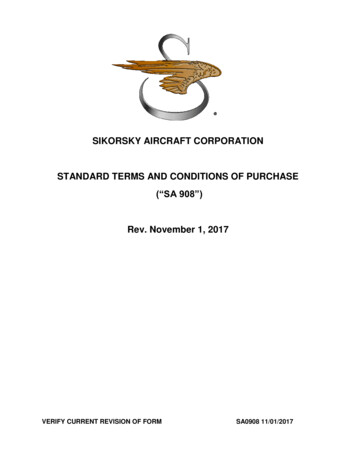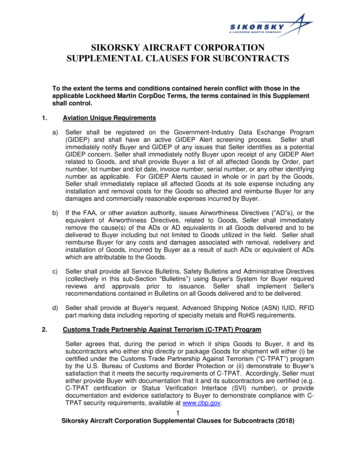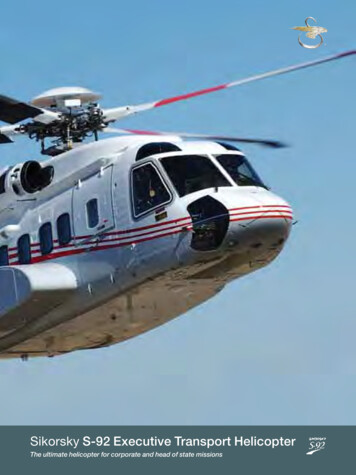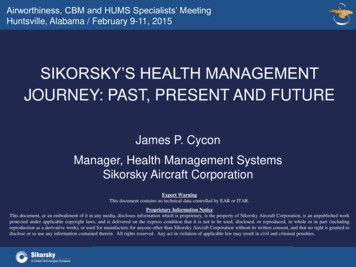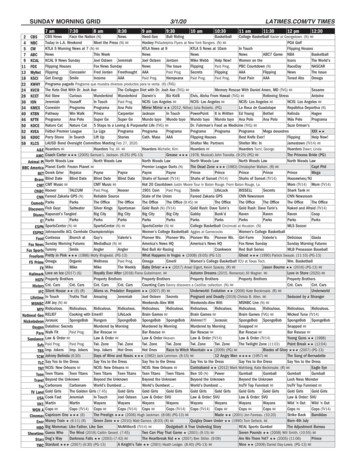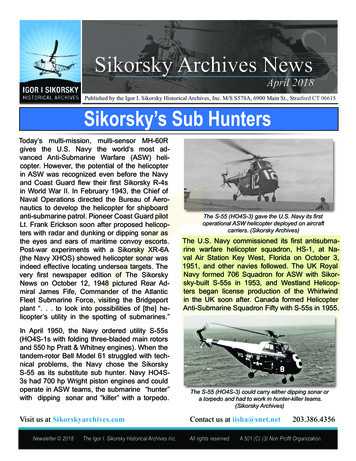
Transcription
Sikorsky Archives NewsApril 2018Published by the Igor I. Sikorsky Historical Archives, Inc. M/S S578A, 6900 Main St., Stratford CT 06615Sikorsky’s Sub HuntersToday’s multi-mission, multi-sensor MH-60Rgives the U.S. Navy the world’s most advanced Anti-Submarine Warfare (ASW) helicopter. However, the potential of the helicopterin ASW was recognized even before the Navyand Coast Guard flew their first Sikorsky R-4sin World War II. In February 1943, the Chief ofNaval Operations directed the Bureau of Aeronautics to develop the helicopter for shipboardanti-submarine patrol. Pioneer Coast Guard pilotLt. Frank Erickson soon after proposed helicopters with radar and dunking or dipping sonar asthe eyes and ears of maritime convoy escorts.Post-war experiments with a Sikorsky XR-6A(the Navy XHOS) showed helicopter sonar wasindeed effective locating undersea targets. Thevery first newspaper edition of The SikorskyNews on October 12, 1948 pictured Rear Admiral James Fife, Commander of the AtlanticFleet Submarine Force, visiting the Bridgeportplant “. . . to look into possibilities of [the] helicopter’s utility in the spotting of submarines.”In April 1950, the Navy ordered utility S-55s(HO4S-1s with folding three-bladed main rotorsand 550 hp Pratt & Whitney engines). When thetandem-rotor Bell Model 61 struggled with technical problems, the Navy chose the SikorskyS-55 as its substitute sub hunter. Navy HO4S3s had 700 hp Wright piston engines and couldoperate in ASW teams, the submarine “hunter”with dipping sonar and “killer” with a torpedo.Visit us at Sikorskyarchives.comNewsletter 2018The Igor I. Sikorsky Historical Archives Inc.The S-55 (HO4S-3) gave the U.S. Navy its firstoperational ASW helicopter deployed on aircraftcarriers. (Sikorsky Archives)The U.S. Navy commissioned its first antisubmarine warfare helicopter squadron, HS-1, at Naval Air Station Key West, Florida on October 3,1951, and other navies followed. The UK RoyalNavy formed 706 Squadron for ASW with Sikorsky-built S-55s in 1953, and Westland Helicopters began license production of the Whirlwindin the UK soon after. Canada formed HelicopterAnti-Submarine Squadron Fifty with S-55s in 1955.The S-55 (HO4S-3) could carry either dipping sonar ora torpedo and had to work in hunter-killer teams.(Sikorsky Archives)Contact us at iisha@snet.netAll rights reserved.203.386.4356A 501 (C) (3) Non Profit Organization.
Sikorsky Archives NewsApril 20182SeabatsThe 7,900 lb S-55 was short of range and payload for ASW. The April 21, 1954 Sikorsky Newsshowed tie-down tests of the new S-58 (NavyXHSS·l), and the photo caption stated simply,“Specifications are classified.” However, with a1,525 hp engine and four-bladed rotor, the 14,000lb S-58 (Navy HSS- 1 or SH-34G) Seabat promised to be a more effective hunter or killer, oneeven compatible with a nuclear depth charge. InSeptember 1955, Sikorsky News reported onthe successful HSS-1 test effort. Navy SquadronHS-3 was the first to receive the HSS-1 in 1955.proved flight instrument and cockpit arrangement, automatic engine RPM controls, and anautomatic hover-coupler. The story explained,“With the coupler, which uses the radar to determine ground motion, it is possible for the pilotto place the helicopter on automatic control at200 feet altitude and 80 knots airspeed and automatically to come to a zero ground speed hover at a 50-foot altitude over a pre-selected spot.”Navy Squadron HS-5 at Quonset Point, RhodeIsland received HSS-1Ns in 1960 and, afterdangerous testing, the Nightdippers made autohover routine. The Sikorsky News reporteddelivery of the 1,000th S-58 in November 1958,an ASW helicopter made in Bridgeport for theU.S. Navy. More S-58 sub-hunters were produced under license by Westland in the UK, Fiatin Italy, and Sud Aviation in France. The March1958 Sikorsky News reported, “Two S-58 helicopters have been purchased by the JapaneseNavy for anti-submarine warfare use. . . [TheS-58] has a payload capacity more than double the S-55 currently in use by the Japanese.”The S-58 (HSS-1) was designed for ASW. Here, aSeabat from HS-4 hovers with dipping sonar near thedestroyer USS Richard B. Anderson in 1958.(U.S. Navy)In 1956, Squadron HS-9 was commissioned atQuonset Point, Rhode Island. Sikorsky Newsreported “The new squadron is to operate fromaircraft carriers of the Leyte class based atQuonset, working with other fleet units such as destroyers, submarines, patrol bombers and blimps.”However, without visual hover references atnight, early Seabat crews could use dippingsonar only in daylight. The Sikorsky News inMay 1958 told of developments in night hovercapability. The new HSS-lN (SH-34J) combinedAutomatic Stabilization Equipment with an im-VisitVisit usus atat Sikorskyarchives.comSikorskyarchives.comThe HSS-1F testbed flew with twin GE T58 turboshaftsin 1957. (Sikorsky Archives)
Sikorsky Archives NewsApril 20183Sea KingsDespite its size, the Seabat was still limited byits single, heavy reciprocating engine. An enginefailure would drop a sonar-dipping helicopter inthe ocean, and though the S-58 could carry sonar and a torpedo at the same time, the weaponcame at the expense of fuel and dramaticallyreduced endurance, especially in hot climates.Sikorsky began investigating turbine powerin the 1940s, and the S-59 (Army XH-39) setspeed and altitude records in 1954 with a Turbomeca turboshaft. General Electric meanwhileproposed a small gas turbine specifically forhelicopters. Twin GE T58s first flew in February 1957 in the first of two HSS-1F test aircraft.The March 1957 Sikorsky News reported “Thenew powerplant, developed for the Navy Bureauof Aeronautics, will replace the Wright R-1820.”When the Navy formulated a requirementfor an ASW helicopter to carry sonar andweapons, it saw turbine power as an Engineering Change Proposal for the HSS-1. Sikorskymade its own proposal on January 31, 1957 fora new five-bladed, twin-turbine helicopter witha boat hull for overwater safety. The SikorskyNews revealed the 18,000 lb sub-hunter taking shape in Stratford and said, “The designalso promises greater range, larger payloadand better visibility than its predecessor, theHSS-1. First flight of the advanced helicopter is scheduled for 1959. Company designation of the new ship is S-61.” A Navycontract was awarded on December 24, 1957,and what should have been the HS2S in service became the HSS-2 (later SH-3A) Sea King.The second S-61 variant in the US Navy (SH-3D) wasthe pattern for export Sea Kings. (Sikorsky Archives)The first of seven YHSS-2 prototypes flew onMarch 11, 1959 with company test pilots Robert Decker and Francis ‘Yip’ Yirrell. The newsub hunter soon broke records. On 17 May,1961 a Sea King clocked 192.7 mph over a 3km course, and on 1 December, another setthree world helicopter speed records: 182.8mph over a 100 km course, 179.5 mph over 500km, and 175.3 mph over 1,000 km. An SH3A reached 210.65 mph on a 20 km course inFebruary 1962, and another, The DawdlingDromedary, set a non-stop helicopter distancerecord flying 2,105.49 miles from the USSHornet off San Diego to the USS Franklin D.Roosevelt off Jacksonville on March 6, 1965.The S-61 mockup constructed at Bridgeport showed thedistinctive Sea King boat hull. (Sikorsky Archives)Contact us atiisha@snet.net
Sikorsky Archives NewsApril 20184First Sea King deliveries began to squadron HS-1in June 1961. The January 1963 Sikorsky Newsreported on Seventh Fleet operations: “U.S. Pacific Fleet Navy men are definitely excited aboutthe new HSS-2 (SH-3A) helicopter. They believethis revolutionary turbocopter has opened a newchapter in the Navy’s book on antisubmarinewarfare.” The story continued, “As the first Navyhelo to combine both hunter and killer capabilities, the SH-3A can detect, identify, track and destroy aggressor submarines. lt can accomplishthis day or night, under all weather conditions.”Canada became the first international SeaKing customer. The first four CHSS-2s (laterCH-124s) left Stratford in May 1963. Subsequent helicopters were assembled from Sikorsky kits by United Aircraft of Canada Ltd (nowPratt & Whitney Canada) at Longueuil, Quebec.The U.S. Navy SH-3A (S-61) evolved into theSH-3D in 1965 with more powerful engines, anuprated main gearbox, and a redesigned tail rotor. The SH-3D was first exported to Spain inJune 1966 and provided the pattern for Sea Kingslicense-built by Westland in the UK, Agusta inItaly, and Mitsubishi in Japan. Westland ASWSea Kings joined the UK Royal Navy in 1970and were later sold to Australia and Germany.The SH-3H hunted with sonar, MAD, radar, and Electronic Support Measures. (Sikorsky Archives)The SH-3D introduced better dipping sonar, butthe U.S. Navy Sea Control Ship concept in theearly 1970s drove development of the multisensor SH-3H with sonar, Magnetic AnomalyDetector, sonobuoys, and search radar. TheU.S. Navy converted 151 Sea Kings to SH3Hs from 1972 to 1982, then recycled SH-3Hsthrough a Service Life Extension Program(SLEP) at Stratford beginning in 1986. SeaKings remained in U.S. Navy service until 2009.Canada was the first international Sea King customerand went on to operate its CH-124s from frigate decksfor 50 years. (Sikorsky Archives)Visit us atSikorskyarchives.com
Sikorsky Archives NewsApril 20185SeahawksThe US Navy put Kaman Seasprite helicopterson first-generation Light Airborne Multi-PurposeSystem (LAMPS I) ships in 1970. The helicopters datalinked sonobuoy returns to their shipsfor processing and used MAD to target submarines and radar to track surface targets.The Navy wanted better sensors and more processing power on LAMPS II. Sikorsky News in April1972 saluted the British WG-13 Lynx helicopterand reported, “Sikorsky is proposing the WG-13 asthe Navy’s LAMPS (light airborne multi-purposesystem) vehicle and would produce the aircraftin this country under license from Westland.”LAMPS II was bypassed, and IBM Systems Integration Division (today Sikorsky Owego) wona Navy contract in 1978 to integrate LAMPS IIIsystems on ships and helicopters. In the competition for the air vehicle, a marinized Sikorsky S-70/UH-60 BLACK HAWK again beat theBoeing YUH-61 designed for the Army Utility Tactical Transport Aircraft System. The newSeahawk was built in the then-new Development Manufacturing Center in Stratford. Sikorsky News reported pilots John Dixson andRichard Mills began testing the first of fiveS-70B-1 (Navy SH-60B) prototypes on December 12, 1979 at the Development FlightCenter near West Palm Beach, Florida.Sikorsky received a Seahawk production contract in September 1981. As LAMPS III co- primecontractor, the helicopter maker integrated SH60Bs built in Stratford with mission electronics from Owego, New York. The first Seahawksquadron, HSL-41, was commissioned at Naval Air Station North Island, California in 1983.Worldwide, the 181 LAMPS III helicopters integrated at Stratford and Owego became powerful battle management assets for the U.S Navy.The S-70B-1 or SH-60B was the airborne portion of the LightAirborne Multipurpose System Mk. III(LAMPS III) and fed sensor data to the ship for processing.(Sikorsky Archives)The S-70B-2 Seahawk was the Roll Adaptive WeaponsSystem developed for the Royal Australian Navy.(Sikorsky Archives)The S-70C(M) Thunderhawk delivered to the Republic ofChina in 1991 evolved from the U.S. Navy S-70B- 4/SH60F CV Helo. (Sikorsky Archives)Contact us atiisha@snet.net
Sikorsky Archives NewsIn 1985 Sikorsky reported delivery of the firstSeahawk for Japan. Mitsubishi Corporation integrated the S-70B-3 (SH-60J) with Japanesesystems and later developed the SH-60J Kaiin service today. A government-to-governmentsale delivered LAMPS III frigates and S-70B1s to Spain in 1988. Unlike the highly integrated LAMPS III, the Royal Australian Navyspecified a more autonomous Role Adaptive Weapons System. Sikorsky was primecontractor for the RAN S- 70B-2with Collins tactical avionics system delivered in 1989.While the Outer Zone SH-60B used sonobuoysto find submarines, the noisy Inner Zone aroundthe CV-class aircraft carrier demanded activedipping sonar for quick, autonomous attack. TheNavy chose the S-70B-4 (Navy SH-60F) withdipping sonar, sonobuoy launcher, and moreautonomous tactical data system. The “CVHelo” first flew at Stratford in March 1987 andentered service with HS-10 at North Island inJune 1989. HS-2 on the Atlantic Coast made thefirst operational deployment in 1990. The Navytook delivery of the last of 82 SH-60F Seahawkson 1 December 1994. However, Sikorsky continues to develop international S-70Bs and hasso far exported Naval Hawks to Brazil, Greece,the Republic of China, Thailand, and Turkey.Naval Hawks and CyclonesApril 20186from carriers and small decks ultimately replacedthe SH-60B, SH-60F, and fixed-wing ASW aircraft.The MH-60R Sea Hawk is the U.S. Navy multi-missionhelicopter with sonar, sonobuoys, search radar, electrooptics, and ESM. (U.S. Navy)The first MH-60R – a remanufactured SH-60B -made its maiden flight July 19, 2001 at Stratfordwith Sikorsky pilots Chris Geanacopoulos andTage Erickson. After flight tests at Naval Air Station Patuxent River, Maryland, it flew to Owegofor mission systems integration. The first operational MH-60R deployment was with HelicopterMaritime Strike squadron HSM-71 on the USSStennis in 2009. Sikorsky Frontlines in 2010 reported the delivery of the 50th MH-60R. By 2018,the U.S. Navy had received 251 MH-60Rs. TheRoyal Australian Navy was the first internationalRomeo operator and took 24 aircraft. Romeo deliveries continue to Denmark and Saudi Arabia.The SH-60B and F were designed for “Blue Water” ASW. However, Navy strike groups todayface quiet submarines in the open ocean andcluttered, shallow littoral regions. The LAMPSIII Block II Upgrade evolved into the moreautonomous MH-60R with Advanced Low Frequency Sonar, Automatic Radar Periscope Detection and Discrimination, multi-spectral electrooptics, and better Electronic Support Measures(ESM). Engineering and Manufacturing Development started in 1993, and Romeo Seahawks flyingAustralia was the first international customer forthe MH-60R. (Australian DoD)Visit us atSikorskyarchives.com
Sikorsky Archives News7April 2018Separate from the Naval Hawk family tree, Sikorsky built 28 S-92/CH148 Cyclones for the Canadian Forces with a mission suite integrated in Canada. Test Pilots John Armbrust and Rick Beckermade the first Cyclone test flight on November14, 2008 at West Palm Beach. The militarized,marinized, fly-by-wire S-92s will be assignedto the 423 Maritime Helicopter Squadron atShearwater, Nova Scotia. Canada will retirethe Sikorsky Sea King late this year after morethan a half-century of sub hunting service.The first CH-148 Cyclone Canadian Maritime Helicopterflew on November 14, 2008 at West Palm Beach.(Sikorsky)Canada now operates the CH-148 Cyclone, the marinized, militarized, fly-by-wire Sikorsky S-92.(Canada DND)Contact us atiisha@snet.net
Sikorsky Archives NewsApril 20188Igor I. Sikorsky Historical Archives Inc.MS S 578A6900 Main StreetStratford, CT 06615-9129Life Membership3 Year Membership1 Year Membership 125 25 10Please send a check or money order (do not send cash)payable to The Igor I. Sikorsky Historical Archives, Inc.Sergei Sikorsky, Lt. Gen. USMC (Ret) Duane Thiessen (President,Naval Aviation Museum – Pensacola, Fl) and Dan Libertino at a Marchvisit to the MuseumPrepared by Frank Colucci and John Bulakowski withgraphic art and layout by Jodi Buckley.Sikorsky Archives NewsM/S S578A, 6900 Main St., Stratford CT 06615Visit us atSikorskyarchives.com
ic Support Measures. (Sikorsky Archives) Canada was the first international Sea King customer and went on to operate its CH-124s from frigate decks for 50 years. (Sikorsky Archives) First Sea King deliveries began to squadron HS-1 in June 1961. The January 1963 Sikorsky News reported on Seventh Fleet operations: "U.S. Pa-

